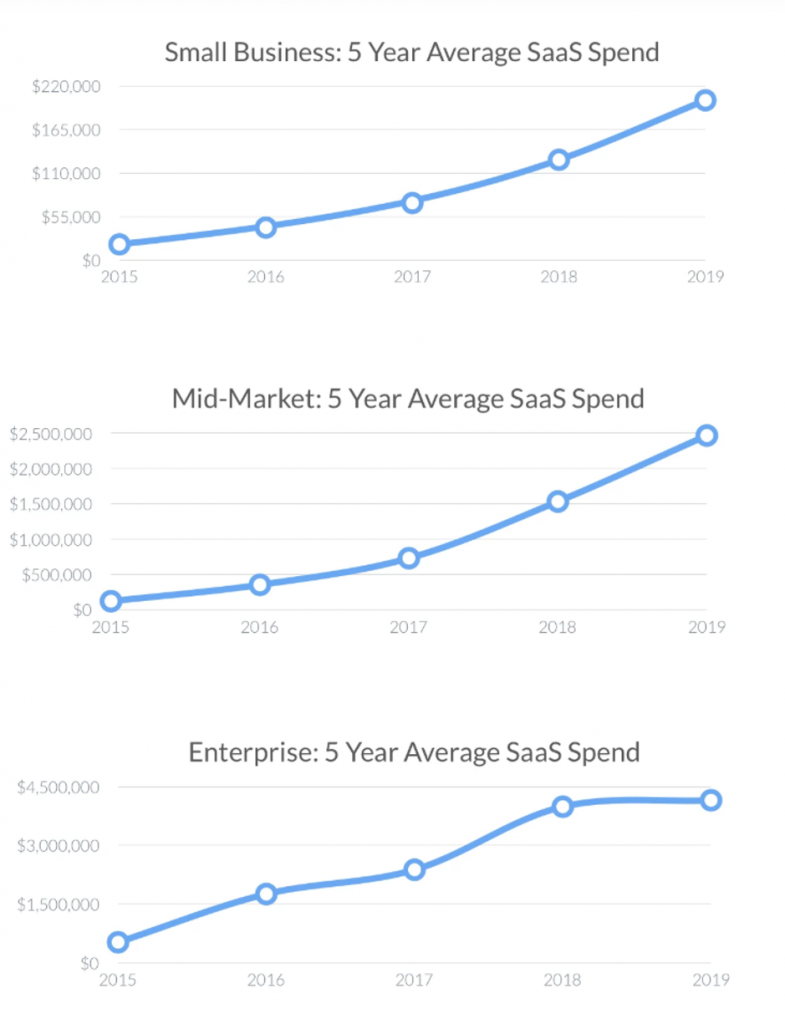SaaS Trends: Are we repeating the same SaaS Management mistakes?
Blissfully have published their latest report into global SaaS Trends. We covered their 2019 report here noting how SaaS usage was growing and that it was frictionless – with 39% of an organisation’s SaaS stack changing annually. In this year’s report we see that waste is still rising, that small and medium size organisations are still not in control of their usage, and that perhaps enterprises are finally doing a better job of managing their spend.
Before we dive in to the 2020 edition, just a note on the insights below. They’re derived from Blissfully’s own customer data, and clearly a Blissfully customer will tend to be a SaaS-first or certainly SaaS-forward organisation. These results may not apply entirely to organisations, perhaps like your own, that are only just setting out on their journey to cloud. However, with SaaS expenditure growing, it’s a question of when, not if, it becomes a spend category requiring greater oversight from your ITAM team.
SaaS wastage on the rise
The raw numbers make for somewhat bleak reading. We’re still wasting money on SaaS apps, with the number of duplicate and orphaned apps detected by Blissfully almost doubling this year. Does your organisation really need to be using Zoom, Webex, and GoToMeeting? Could you reduce costs by removing duplicates and standardising on one? Likewise, do you know how many apps you’re paying for that have fallen out of favour for the new kid on the block? Using the example above, Zoom is busy eating Webex and GoToMeeting’s market share.
Poor security is the norm
Another worrying finding is that out of the Top 1000 SaaS apps managed by Blissfully, only 18% are fully SOC2 compliant. SaaS Governance, Risk, and Compliance is a growing trend in response to new requirements such as CCPA, SHIELD (no, not that S.H.I.E.L.D), and GDPR. These figures indicate that there is potentially a big problem lurking in your SaaS estate if you need to prove you’re complying with your industry’s regulatory requirements. This goes beyond just regulatory compliance though, one of the recurring themes I encountered in customer references for my SaaS Management Market Report is that increasingly investors are paying attention to the SaaS stack a startup is using. One reference even highlighted that in order to move forward with their IPO they needed to have full visibility of their estate. As we’ll see next uncontrolled SaaS usage is a problem for startups and this is where some of the more agile SaaS Management tool providers have a role to play.
Are enterprises getting to grips with SaaS?
In more positive news, Blissfully are seeing evidence that enterprises (which they define as those with more than 1000 employees) use less unique SaaS apps per employee than smaller organisations, and spend less per employee per year on apps. Is this evidence that larger organisations are doing a better job of managing SaaS? The raw spend growth figures below seem to indicate this – spend per employee was relatively flat for enterprises between 2018 & 2019 whereas small and mid-market spending grew around 45%.
Blissfully surmise that this is evidence of IT departments in enterprises working to control spending and build a standard set of SaaS applications and I would tend to agree. Organisations with more than 1000 employees are likely to have in-house procurement teams and legal support. For smaller firms, startups such as Vendr & Cledara can provide those services as a service.
Stakeholders are changing
SaaS started and gained a foothold outside core support functions such as IT, HR, and Customer Support. Sales, Marketing, and Finance were all early adopters, often bypassing IT with extensive Shadow IT programmes. That’s changing. Blissfully have seen usage of SaaS apps by IT & Security almost double in two years. Customer support has grown by over 50%, and HR by slightly less. It’s time to speak to your colleagues in IT and help your Customer Support/Service teams manage their SaaS.
There’s more insight available in the full report – including the most popular apps per department and function. Some surprises there – particularly that GSuite, Zoom, and Slack are leading Office365 in both usage and spending. That may be a strong indicator of the type and size of customer that Blissfully have.
You can download it here – https://www.blissfully.com/saas-trends/2020-annual-report/
If you’re not yet managing your SaaS estate or would like an overview of the tools available please download our popular SaaS Management Market Report via this link
Can’t find what you’re looking for?
More from ITAM News & Analysis
-
Software Vendor Insights: What do the numbers tell us about the opportunities for ITAM negotiations?
What software vendor insights can be gained from the latest financial results from Amazon, Google, Broadcom, Salesforce, IBM and SAP? An important part of ITAM is paying close attention to the health of the companies we ... -
Flexera is first SAM tool vendor verified for Oracle E-Business Suite applications
Flexera has announced that it has been verified as the first software asset management (SAM) tool vendor for Oracle E-Business Suite applications. Almost anyone with an Oracle estate will be familiar with the company’s License Management ... -
ITAMantics - March 2024
Welcome to the March 2024 edition of ITAMantics, where George, Rich and Ryan discuss the month’s ITAM news. Up for discussion this month are. Listen to the full ITAMantics podcast above or queue it up from ...
